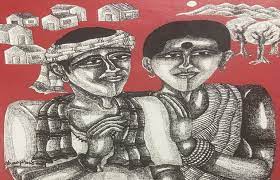Drawing with charcoal is one of the first methods taught to students attending art school. When used on paper, charcoal has a distinctive appearance and feel that is ideal for helping a beginner artist hone their skills. And despite the wide variety of pencils, chalks, and crayons that artists use when drawing, charcoal frequently continues to be a favourite for many due to its adaptability. Consider adding charcoal to your list of drawing mediums if you’re just starting out and explore all the possibilities it offers.
Lets learn about this beautiful indian Artwork!
Making charcoal paintings
When beginning life drawing, new artists are frequently advised to work with charcoal right away. This is so that you may easily create a variety of distinct lines with charcoal. Charcoal can be shaded using your fingers or a piece of paper, highlighted by swiftly removing small parts, or lined with an edge.
Using a versatile tool like charcoal enables the artist to make a range of effects to acquire the desired style quickly and without having to take the time to select and reselect materials, which is useful for inexperienced painters who frequently have to practise drawing the same lines over and over again.
Charcoal applies to the paper with little pressure as well, allowing the artist to work rapidly and continuously without getting tired. If you’re taking a drawing class for the first time, you might want to buy some charcoal so you can draw faster and learn more.
Choosing the materials and charcoal
Similar to other media, charcoal paintings is available in a variety of forms. Each offers unique qualities, thus your final decision will mostly be influenced by your preferences.
Soft or Hard
Charcoal is available in a range of varying hardness ratings, just like pencils. The charcoal will form a lighter line on the paper the harder it is used. For their ability to blend or draw deeper lines, some people choose to use very soft charcoals, whereas others favour a medium grading that falls between hard and soft.
H stands for hard and B for soft in the rating system for pencil hardness. Frequently, 3H is the toughest and 3B is the softest. The centre rating is HB.
The hardest charcoal is HB, and the softest is 6B. Remember that firmer charcoals will create a cleaner, sharper edge while softer charcoals will result in darker lines and be easier to smudge. You can discover that you favour one style or technique over another depending on your personal preferences. For instance, HB charcoal will produce better results if you prefer to cross hatch, whereas 4B to 6B charcoal will be more convenient if you prefer to smear with paper and highlight with an eraser.
Bamboo Charcoal
It’s not necessary to compress charcoal into a stick or set it inside a pencil; occasionally, you can utilise a piece of charcoal that was created by burning other materials, such as sticks.
Long sticks of vine charcoal, a common drawing media, are available for purchase. It has a long, thin, and slightly curved shape and is crafted from burned grape vine parts. Vine charcoal is both more delicate and slightly tougher than crushed charcoal. It is ideal for adding very light, delicate lines and shading all over a drawing.
Holders
Working with charcoal can become messy, especially if you use the softer types. For this reason, a lot of people decide to use a metal or plastic charcoal container. This is also perfect for lengthening your charcoal piece, which can increase its life and make it more manageable.
Handled Eraser
The kneaded eraser is among the greatest sorts of erasers for charcoal, however there are many more. An eraser that has been kneaded can be shaped and worked like dough or clay since it is so soft. Both the regular eraser and the smudging tool can be used to mix some charcoal into lighter, finer regions. The traditional eraser can be used to remove a part of the charcoal and create a highlight.
Rolled paper or a paper cone
Although you can smear charcoal with your finger tips or a kneaded eraser, you might also find it useful to have a paper cone or a piece of rolled paper on hand. Unlike the eraser, which removes charcoal from the page, the paper cone is used to smear and blend the charcoal. Without having to make additional markings on the page, this is ideal for adding shadows and shade.



